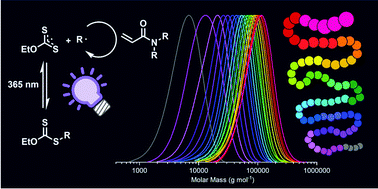The difference between photo-iniferter and conventional RAFT polymerization: high livingness enables the straightforward synthesis of multiblock copolymers†
Abstract
Photo-iniferter (PI)–RAFT polymerization, the direct activation of chain transfer agents via light, is a fascinating polymerization technique, as it overcomes some restriction of conventional RAFT polymerization. As such, we elucidated the role of reversible deactivation in this context using a monomer–CTA pair with low chain transfer capabilities. Tests with varying targeted degrees of polymerization (DP) or monomer concentrations revealed no significant improvement of polymerization control using the PI-process. Control can however be achieved via slow monomer addition, increasing the number of activation/deactivation events per monomer addition. More importantly, the livingness of the polymerization was found to be extraordinarily high, enabling the straightforward and rapid synthesis of multiblock copolymers with up to 20 blocks and a high number of repeating units per block (DP = 25–100) maintaining an overall excellent definition (Mn = 90 300 g mol−1, Đ = 1.29). This study highlights the enormous potential of PI–RAFT polymerization for the synthesis of polymeric materials.

- This article is part of the themed collections: Polymer Chemistry Emerging Investigators Series and Polymer Chemistry Most Popular 2022


 Please wait while we load your content...
Please wait while we load your content...